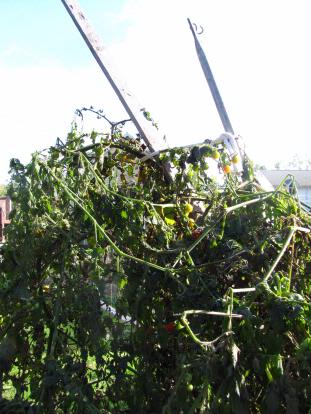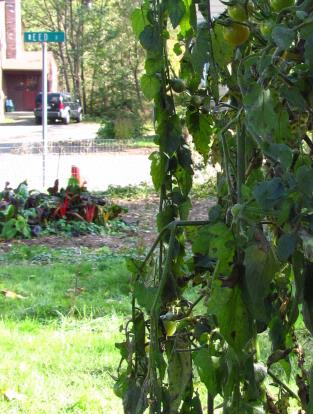Many of our crops must live their lives bracketed by the last frost in the spring and the first frost in the fall. Some years that first frost just coats the plants with icy beards before giving way to another week or two of frost free nights. With the exception of truly pusillanimous plants (like basil), most make it through that little nip. Eventually though, we get a “hard” freeze and lose any but the hardy plants. This year the temperature dropped into the twenties on October 12th. If you inspect your neighborhood using the tools at www.plantmaps.com, you’ll see that even an individual street here in the valley can have different average frost dates, this is about right for my area.
Like a diligent gardener, I collected all of the peppers and tomatoes, performed extreme unction on the plants and retreated to my warm house. The next morning the sprawling tomato plant had been reduced to a mushy mess of leaves. The pole beans still clung to their trellis but the leaves just hung limp. I picked a bean and could bend it in two before it snapped. Yet just two rows over the brussels sprouts looked unfazed; if anything the sprouts were sweeter.
It should come as no surprise that some plants are hardier than others. We can’t grow bananas or coffee in the northeast, yet even after a drop into the twenties there are plenty of green plants around. To prevent ice on sidewalks people sometimes add salts. This lowers the freezing temperature. Some plants do something similar to prepare for freezes.
Plant cells are like rigid boxes filled with pressurized balloons. The plant body consists of thousands of these boxes stacked on top of one another. Herbaceous plants remain standing in part because of the pressure of the “balloons” on the “boxes.” When the temperature drops below freezing, the water between the cells freezes first because it has less stuff dissolved in it. This changes the osmotic properties of the system and will draw water out of the cells. The cell’s fatty membrane collapses and ruptures. That’s what leaves the plants a mushy mess: their cells are all broken, and the boxes collapse. Sad plants.
Hardy plants prepare as the temperature drops over a few weeks by changing their membranes and adding a lot of dissolved sugar to their cells. This protects them in much the same way that throwing salt on your sidewalk changes its freezing temperature. In July if you took a cabbage plant and stuck it in a freezer, its cells would fare poorly.
Pretty cool, but not nearly as gob smackingly cool as the wood frog. This little critter pulls the same trick with the sugar, but in addition pumps water to the periphery of its body. There it freezes solid. The frog’s heart stops. When warmer weather comes, it can wake up and hit the ground hopping. If only I could get my tomato plants to man up like that little frog.
Many of our crops must live their lives bracketed by the last frost in the spring and the first frost in the fall. Some years that first frost just coats the plants with icy beards before giving way to another week or two of frost free nights. With the exception of truly pusillanimous plants (like basil), most make it through that little nip. Eventually though, we get a “hard” freeze and lose any but the hardy plants. This year the temperature dropped into the twenties on October 12th. If you inspect your neighborhood using the tools at www.plantmaps.com, you’ll see that even an individual street here in the valley can have different average frost dates, this is about right for my area.
Like a diligent gardener, I collected all of the peppers and tomatoes, performed extreme unction on the plants and retreated to my warm house. The next morning the sprawling tomato plant had been reduced to a mushy mess of leaves. The pole beans still clung to their trellis but the leaves just hung limp. I picked a bean and could bend it in two before it snapped. Yet just two rows over the brussels sprouts looked unfazed; if anything the sprouts were sweeter.

It should come as no surprise that some plants are hardier than others. We can’t grow bananas or coffee in the northeast, yet even after a drop into the twenties there are plenty of green plants around. To prevent ice on sidewalks people sometimes add salts. This lowers the freezing temperature. Some plants do something similar to prepare for freezes.
Plant cells are like rigid boxes filled with pressurized balloons. The plant body consists of thousands of these boxes stacked on top of one another. Herbaceous plants remain standing in part because of the pressure of the “balloons” on the “boxes.” When the temperature drops below freezing, the water between the cells freezes first because it has less stuff dissolved in it. This changes the osmotic properties of the system and will draw water out of the cells. The cell’s fatty membrane collapses and ruptures. That’s what leaves the plants a mushy mess: their cells are all broken, and the boxes collapse. Sad plants.

Hardy plants prepare as the temperature drops over a few weeks by changing their membranes and adding a lot of dissolved sugar to their cells. This protects them in much the same way that throwing salt on your sidewalk changes its freezing temperature. In July if you took a cabbage plant and stuck it in a freezer, its cells would fare poorly.
Pretty cool, but not nearly as gob smackingly cool as the wood frog. This little critter pulls the same trick with the sugar, but in addition pumps water to the periphery of its body. There it freezes solid. The frog’s heart stops. When warmer weather comes, it can wake up and hit the ground hopping. If only I could get my tomato plants to man up like that little frog.
Related




